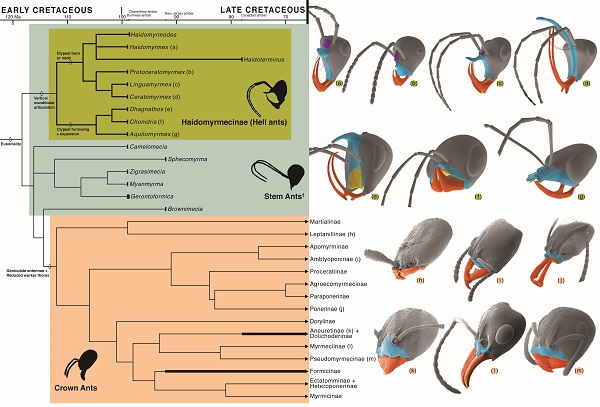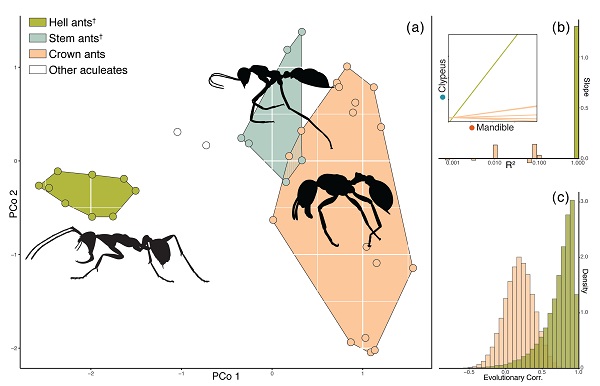Among the earliest fossil ants known, haidomyrmecine ‘hell ants’ from Cretaceous amber reveal an ancient and dramatic early burst radiation of adaptive forms. These eusocial Cretaceous taxa diverged from extant lineages prior to the most recent common ancestor of all living ants and possessed bizarre scythe-like mouthparts along with a striking array of horn-like cephalic projections. Despite the morphological breadth of the fifteen thousand known extant ant species, phenotypic syndromes found in the Cretaceous are without parallel and the evolutionary drivers of extinct diversity are unknown.
Now, an international research group from U.S., France, and China has proposed a mechanistic explanation for aberrant hell ant morphology, and thus providing new insight into the evolution of hell ants. The research was co-led by Prof. WANG Bo from the Nanjing Institute of Geology and Palaeontology (NIGPAS) of the Chinese Academy of Sciences. Results were published in Current Biology on August 6.
The researchers have provided a mechanistic explanation for aberrant hell ant morphology through phylogenetic reconstruction and comparative methods, as well as a newly reported specimen. They reported a remarkable instance of fossilized predation that provides direct evidence for the function of dorsoventrally-expanded mandibles and elaborate horns.
These findings confirmed the hypothesis that hell ants captured other arthropods between mandible and horn in a manner that could only be achieved by articulating their mouthparts in an axial plane perpendicular to that of modern ants. The head capsule and mandibles of haidomyrmecines are uniquely integrated as a consequence of this predatory mode and covary across species while finding no evidence of such modular integration in extant ant groups.
The results of this study suggest an extinct early burst adaptive radiation into morphospace that is unoccupied by any living taxon, triggered by an innovation in mouthpart movement and subsequent modular covariation between mandible and horn. The new results also suggest that hell ant cephalic integration – analogous to the vertebrate skull – triggered a pathway for an ancient adaptive radiation and expansion into morphospace unoccupied by any living taxon.
Reference: Barden P.*, Perrichot V.*, Wang Bo* (2020) Specialized predation drives aberrant morphological integration and diversity in the earliest ants. Current Biology. https://doi.org/10.1016/j.cub.2020.06.106.

Reconstructions of haidomyrmecine hell ants

Phylogeny and cephalic homology of hell ants and modern lineages

Morphospace and evolutionary integration of living and Cretaceous ants
Download:
